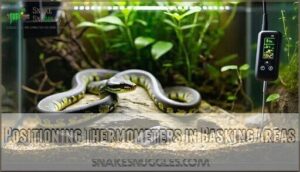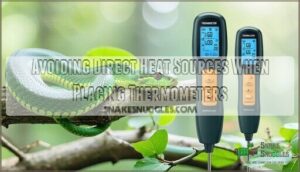This site is supported by our readers. We may earn a commission, at no cost to you, if you purchase through links.
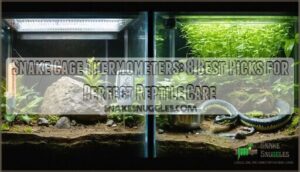
Temperature accuracy isn’t just important—it’s life-or-death for cold-blooded reptiles who can’t regulate their own body heat.
Digital thermometers with probes work best, giving you precise readings for both basking spots (usually 88-95°F) and cool zones (75-80°F).
Infrared temp guns are handy for quick surface checks, while combo thermometer-hygrometers track humidity too.
Don’t rely on stick-on strips—they’re notoriously inaccurate and can mislead you when your snake needs consistent temperatures for proper digestion and immune function.
Smart thermometers with phone alerts can prevent disasters when heating elements fail unexpectedly.
Table Of Contents
- Key Takeaways
- Essential Snake Cage Temperature Ranges and Gradients
- 8 Best Snake Cage Thermometers for Accurate Monitoring
- 1. Reptile Tank Thermometer Hygrometer Display
- 2. Reptile Tank Thermometer Humidity Gauge
- 3. Digital Thermometer Hygrometer 2 Pack
- 4. Exo Terra Reptile Thermometer
- 5. Reptile Thermometer Humidity Gauge
- 6. Reptile Terrarium Thermometer Hygrometer
- 7. Reptile Thermometer Hygrometer with USB Charging
- 8. Reptile Thermometer High Range
- Optimal Placement of Thermometers in Snake Enclosures
- Types
- Frequently Asked Questions (FAQs)
- What temperature should my snake cage be at?
- Where to put a thermometer in a snake cage?
- What is the best reptile thermometer?
- How to check temperature in terrarium?
- What temperature should a snake cage be?
- Where do you put a thermometer in a snake cage?
- How do you check the temperature of a snake tank?
- How do I raise the temperature in my snake cage?
- How often should I calibrate my snake cage thermometer?
- Can I use a human thermometer for my snakes cage?
- Conclusion
Key Takeaways
- You’ll need digital thermometers with probes for accurate readings – they’re far more reliable than stick-on strips that can mislead you about critical temperatures your snake needs for proper digestion and health.
- Place multiple thermometers throughout your enclosure – position one in the basking area (88-95°F), another in the cool zone (75-80°F), and avoid direct contact with heat sources to prevent false readings.
- Smart thermometers with phone alerts can save your snake‘s life – they’ll notify you immediately when heating equipment fails, preventing dangerous temperature drops that could be fatal to your cold-blooded pet.
- Create proper thermal gradients specific to your snake species – different species, like ball pythons, corn snakes, and boas, have distinct temperature requirements, and consistent monitoring ensures they can thermoregulate naturally.
Essential Snake Cage Temperature Ranges and Gradients
You’ll need to understand your snake’s specific temperature requirements before setting up monitoring equipment.
Different species require distinct temperature ranges and thermal gradients to maintain proper health, digestion, and behavior in captivity.
Ideal Temperature Ranges for Different Snake Species
Understanding snake species temperature needs is vital for maintaining your pet’s health.
Each species has evolved specific temperature requirements that directly impact their metabolism, digestion, and overall well-being.
Ball pythons require 78-80°F ambient temperatures with basking spots at 88-92°F.
Their cool zones should maintain 75-80°F to prevent stress.
Corn snakes thrive in 75-82°F ambient conditions with basking areas reaching 85-88°F.
They tolerate cooler nighttime temperatures down to 65°F.
Boa constrictors need warmer conditions at 82-86°F ambient with basking spots at 88-92°F.
Their cool zones shouldn’t drop below 78°F.
These temperature ranges guarantee proper thermoregulation, supporting healthy shedding, appetite, and immune function across different snake species.
Creating Proper Thermal Gradients in Snake Enclosures
Creating a proper thermal gradient transforms your snake enclosure into a temperature highway.
You’ll need a basking distance of 6-8 inches from heat sources, while your cool zone should sit 10-15 degrees lower.
Substrate temperature matters too—use thermostat integration to maintain consistent readings.
| Zone | Temperature Range | Equipment |
|---|---|---|
| Basking | 88-95°F | Heat lamp, ceramic heater |
| Warm side | 80-85°F | Under-tank heater |
| Cool side | 75-80°F | Ambient temperature |
| Substrate | 78-82°F | Probe thermometer |
Your snake enclosure temperature should flow seamlessly from warm to cool, giving your reptile choices for thermoregulation.
Importance of Basking Spots and Cool Zones
Your snake’s basking spots and cool zones work like a personal climate control system. Basking Benefits include improved Digestion Efficiency and Shedding Success, while cool zones prevent overheating. This setup supports your snake’s Thermoregulation Needs and Immune Support.
Think of basking spots and cool zones as your snake’s personal thermostat – they choose their comfort level naturally.
Here’s why both zones matter:
- Temperature gradient allows natural behavior selection
- Snake temperature requirements vary by species and activity
- Snake cage thermometers help monitor both zones accurately
- Proper placement prevents stress and health issues
- Balanced zones mimic natural habitat conditions
To maintain proper health, keep consistent temperatures for digestion.
Nighttime Temperature Requirements for Snakes
During evening hours, your snake’s nighttime temperature requirements differ from daytime needs.
Most species benefit from a nocturnal temperature drop of 5-10°F, mimicking natural conditions.
Here’s what to monitor:
- Safe Temperature Ranges: Maintain 70-75°F for most species during night hours
- Heating Pad Usage: Use ceramic heaters or under-tank heaters for consistent warmth
- Species-Specific Needs: Tropical snakes need warmer nights than temperate species
- Monitoring Night Temps: Check snake cage thermometers regularly for proper snake enclosure temperature
Seasonal Temperature Variations for Captive Snakes
Just like your nighttime routine, seasonal variations keep your snake healthy year-round.
Winter brumation requires gradually lowering temperatures by 5-10°F over several weeks, mimicking natural cycles. Your snake cage thermometers help monitor these changes precisely.
Spring shedding needs warmer conditions to support growth, while fall feeding prepares snakes for cooler months. Summer adjustments focus on preventing overheating.
Humidity changes accompany temperature shifts, so monitor both carefully. Maintaining proper vivarium environmental conditions is essential for reptile well-being.
These seasonal variations support natural snake health patterns when managed properly.
8 Best Snake Cage Thermometers for Accurate Monitoring
You’ll need accurate thermometers to monitor your snake’s temperature precisely since even small variations can affect their health and behavior.
The right thermometer helps you maintain proper thermal gradients and catch temperature fluctuations before they become dangerous.
1. Reptile Tank Thermometer Hygrometer Display
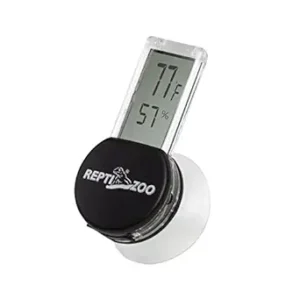
This thermometer hygrometer combo gives you dual monitoring for both temperature and humidity in your snake’s enclosure.
The clear LCD screen displays readings from 14–122°F and 10–95% humidity, covering most snake species’ requirements.
You’ll appreciate the suction cup mounting that sticks firmly to glass surfaces, plus the included external probe with a 36-inch cable for flexible placement.
The device runs on battery power, eliminating messy cables inside your terrarium.
With ±1°C temperature accuracy and ±5% humidity precision, it’s reliable for daily monitoring.
The compact design won’t dominate your tank’s aesthetics, while the max/min memory function tracks environmental fluctuations over time.
Remember to clean both the glass and suction cup with rubbing alcohol for ideal adhesion.
This thermometer works best in glass enclosures rather than PVC setups.
Best For: Snake and reptile owners who need accurate, daily monitoring of temperature and humidity in glass enclosures.
- Dual monitoring of temperature and humidity with easy-to-read LCD display.
- Flexible mounting options including suction cup and external probe for precise placement.
- Reliable accuracy with compact design and long battery life.
- Suction cup adhesion can be inconsistent, especially in non-glass enclosures.
- Not fully waterproof and may be damaged by excessive moisture.
- Display readability may require modifications like white tape for better contrast in certain setups.
2. Reptile Tank Thermometer Humidity Gauge
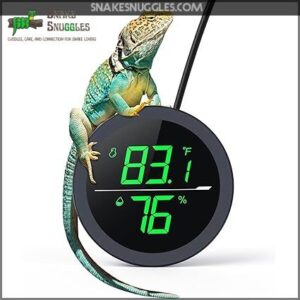
When you’re serious about maintaining perfect conditions for your snake, the PAIZOO reptile tank thermometer humidity gauge delivers exceptional monitoring capabilities.
This 2-in-1 device combines accurate temperature and humidity readings with a 3-inch backlit LED display that’s crystal clear even in dim lighting conditions.
The unit features built-in high-precision measurement chips that outperform traditional analog methods, ensuring your readings stay within reliable ranges.
Its energy-efficient LED display provides continuous monitoring without draining power, while the 140cm USB cable offers flexible placement options throughout your enclosure.
Installation couldn’t be simpler – just use the included 3M double-sided tape for secure mounting.
The sleek black design blends seamlessly with any terrarium setup, and the plug-and-play functionality means you’ll have accurate readings immediately.
With dual vents ensuring precise measurements, this thermometer helps you maintain that vital environmental balance your snake needs to thrive.
To achieve ideal results, understanding reptile humidity levels is essential for creating a healthy environment.
Best For: Snake and reptile owners who want precise, easy-to-read temperature and humidity monitoring for their enclosures.
- Accurate digital readings for both temperature and humidity with high-precision sensors.
- Bright, easy-to-read 3-inch LED display and simple plug-and-play setup.
- Long USB cable allows flexible placement in larger tanks.
- Mixed user feedback on measurement accuracy and occasional malfunctions.
- Wire placement may be inconvenient inside some terrariums.
- Some users report product failure within a week of use.
3. Digital Thermometer Hygrometer 2 Pack
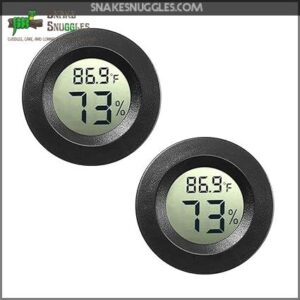
When you’re monitoring both temperature and humidity in your snake’s enclosure, this Digital Thermometer Hygrometer 2 Pack delivers dual functionality in compact units.
Each device measures approximately 1.8 x 1.1 inches and provides real-time readings updated every 10 seconds.
The temperature range spans -50°C to 70°C (-58°F to 158°F), while humidity coverage extends from 10% to 99% RH.
Temperature accuracy sits within ±1°C, and humidity readings maintain ±5% RH precision.
You’ll appreciate the clear LCD display that’s readable from across the room.
The dual pack format lets you monitor different zones simultaneously – place one in your snake’s basking area and another in the cool zone.
Battery-powered operation typically lasts several months, and the adhesive backing guarantees secure placement without disrupting your pet’s habitat.
Best For: Snake owners and reptile keepers who need reliable, affordable monitoring of temperature and humidity in different zones of their enclosure.
- Compact size, clear LCD, and dual-unit pack for easy placement and simultaneous zone monitoring
- Accurate real-time temperature and humidity readings with quick sensor response
- Long battery life with included spare batteries and simple installation
- Humidity readings don’t go below 10%, limiting use in extremely dry environments
- Display becomes hard to read above 50°C and initial strong odor reported when opening
- Battery type (LR44) can be unclear in description and tricky to replace if using adhesive backing
4. Exo Terra Reptile Thermometer
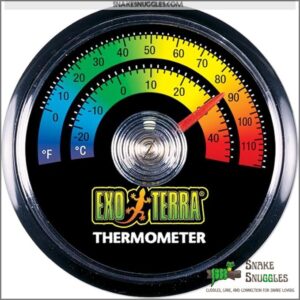
Perfect for budget-conscious snake keepers, the Exo Terra Reptile Thermometer delivers reliable temperature monitoring at just $3.99.
This analog dial displays both Celsius and Fahrenheit with crystal-clear readability. The adhesive dot installation makes setup effortless on smooth surfaces, while the lightweight design won’t overwhelm your enclosure’s aesthetic.
Though some users report adhesive weakening in high-heat environments, most find it holds strong under typical reptile conditions.
The 7-inch diameter guarantees easy visibility without magnification, making temperature checks quick and hassle-free. No batteries required means continuous, worry-free operation for your snake’s comfort.
Best For: Budget-conscious snake owners seeking simple, reliable temperature monitoring without digital features.
- Adhesive may weaken in high-heat environments.
- Analog design requires a direct line of sight for accurate reading.
- Not ideal for low-profile setups due to its larger 7-inch diameter.
- No batteries needed for continuous, hassle-free operation.
- Clear analog display in Celsius and Fahrenheit with easy-to-read dial.
- Strong adhesive holds well, and lightweight design suits most enclosures.
5. Reptile Thermometer Humidity Gauge
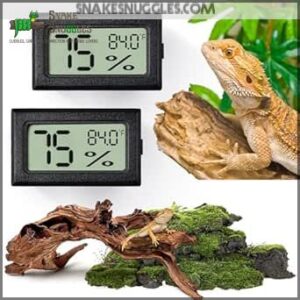
This dual-purpose device takes the guesswork out of reptile care by monitoring both temperature and humidity levels simultaneously.
You’ll appreciate its 0.9°F accuracy for temperature readings and reliable humidity measurements within 3% of actual levels.
The LED screen provides clear visibility even in dim environments, while the cordless design keeps your snake’s habitat neat and uncluttered.
Battery-powered operation guarantees long-term reliability without frequent replacements, and installation is simple with included double-sided adhesive, though placement away from direct misting prevents temporary accuracy issues, ensuring reliable humidity measurements.
Best For: Reptile and terrarium owners who want straightforward, accurate temperature and humidity monitoring with easy installation.
- Reliable 0.9°F temperature accuracy and consistent humidity readings within 3%.
- Clear LED screen and cordless, battery-powered design for clutter-free setup.
- Simple, tool-free installation with included adhesive and quick ℉/℃ switching.
- Sharp edges may pose risks to reptiles and may require sanding.
- Not suitable for direct misting, as moisture can temporarily affect accuracy.
- Adhesive tape included but not the stronger adhesive described in some listings.
6. Reptile Terrarium Thermometer Hygrometer
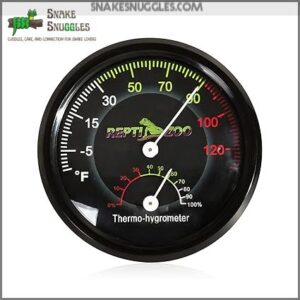
Your snake’s habitat deserves the REPTI ZOO Thermometer Hygrometer’s reliable monitoring capabilities.
This analog device features color-coded segments that make temperature readings crystal clear, while the dual functionality tracks both temperature and humidity without requiring batteries.
Installation couldn’t be simpler – just peel and stick the adhesive pad wherever you need it most.
The temperature gauge delivers accurate readings that help maintain your snake’s ideal environment.
However, the hygrometer’s accuracy can be questionable, so you might want to cross-reference humidity levels with another device.
Some users report the adhesive losing its grip over time, but switching to Velcro tape solves this issue while allowing easy removal for cleaning.
With a 12-month quality guarantee, this budget-friendly option provides peace of mind for conscientious snake keepers.
Best For: Snake keepers and reptile owners seeking a simple, battery-free solution for monitoring temperature and humidity with easy installation.
- Hygrometer accuracy may be unreliable and should be checked against another device.
- Adhesive pad may fail over time, potentially requiring Velcro replacement.
- Analog display could be less precise compared to digital models.
- No batteries required, making it eco-friendly and low maintenance.
- Clear, color-coded temperature readings for easy monitoring.
- Easy to install with included adhesive pad.
7. Reptile Thermometer Hygrometer with USB Charging
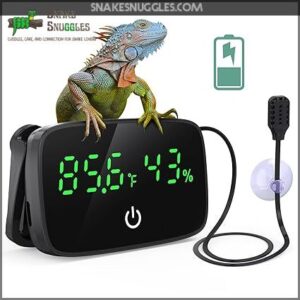
Transform your snake care routine with the PAIZOO Reptile Thermometer Hygrometer’s innovative USB charging system.
This digital powerhouse eliminates the hassle of battery replacements while delivering precise temperature readings from 32°F to 140°F and humidity monitoring from 5% to 99%.
The LED high-definition display activates with a simple touch, providing crystal-clear readings even during nighttime checks.
Its 31.5-inch probe cord offers flexible placement throughout large enclosures, while the adjustable back stand accommodates three viewing angles.
You’ll appreciate the 3-second sampling interval that guarantees real-time monitoring of your snake’s environment.
The sleep mode conserves energy after 15 seconds of inactivity, making this thermometer both efficient and reliable for long-term use.
Best For: Reptile keepers who want accurate, hassle-free temperature and humidity monitoring with easy USB charging and simple operation in larger enclosures.
- Display turns off after 15 seconds, which may bother users wanting always-on readings.
- Some users report minor discrepancies in temperature or humidity accuracy.
- Cord length may be limited for exceptionally large tanks or custom setups.
- Accurate, real-time readings every three seconds with touch-activated LED display.
- No battery hassles—USB charging and energy-saving sleep mode.
- Flexible placement with 31.5-inch probe cord, adjustable stand, and adhesive backing.
8. Reptile Thermometer High Range
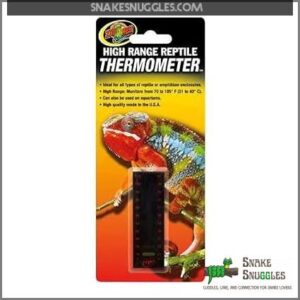
Monitoring extreme temperatures becomes essential when your snake requires basking spots above 100°F.
High-range thermometers measure up to 140°F, ensuring accurate readings for species like ball pythons and boas that need elevated heat zones.
These devices use thermocouple technology for rapid response to temperature changes, maintaining accuracy within ±1°F across the full spectrum.
Their heat-resistant construction and waterproof casings withstand demanding environments, while large LCD displays provide clear visibility even in low-light conditions.
You’ll get reliable monitoring that prevents overheating and supports safe thermal gradients for tropical and desert species, ensuring a stable environment with accurate readings.
Best For: Snake and reptile owners who need precise monitoring of high basking temperatures above 100°F in demanding enclosure environments.
- Not reusable or repositionable once attached, limiting placement flexibility.
- May require horizontal mounting for most accurate reading, which can look awkward in some enclosures.
- Accuracy may be affected by proximity to heat lamps or hot spots, requiring careful sensor placement.
- Maintains accuracy within ±1°F, ensuring safe thermal gradients for sensitive species.
- Heat-resistant and waterproof build stands up to high temperatures and humidity.
- Large LCD display offers clear, easy-to-read temperature readings even in low-light setups.
Optimal Placement of Thermometers in Snake Enclosures
Getting thermometer placement right in your snake’s enclosure makes the difference between accurate monitoring and misleading readings that could harm your pet.
You’ll need to position these devices strategically at multiple locations to capture the full temperature picture your snake experiences throughout its habitat.
Positioning Thermometers in Basking Areas
Perfect thermometer placement in your snake’s basking area requires strategic positioning for accurate readings.
Place your reptile thermometer 2-3 inches from the heat source to avoid direct exposure while capturing true basking spot temperature. Consider using a reptile basking thermometer for maximum temperature control.
- Basking Distance: Position the snake cage thermometer close enough to measure the temperature gradient your snake experiences
- Angle Matters: Mount the probe placement at snake level, not against the glass where heat concentrates
- Avoiding Burns: Keep thermometers away from direct contact with heating elements to prevent damage and guarantee accurate readings
Monitoring Cool Zones With Thermometers
Your snake’s retreat area needs proper reptile temperature monitoring just like the basking spot.
Position a reptile thermometer about one inch above the substrate in the cool zone to track cool zone temperature accurately. This accurate placement prevents false readings from substrate contact while ensuring your snake temperature gradient stays within your species’ requirements.
Consider where to source reptile cool zone products for ideal setup. Choose a quality thermometer choice for reliable species needs monitoring, and keep snake cage accessories away from sensors to avoid avoiding obstructions that compromise readings.
Using Multiple Thermometers for Accurate Readings
You’ll want multiple thermometers as essential snake cage accessories for reliable reptile temperature monitoring.
Place one in your basking area, another in the cool zone, and a third for ambient readings.
This gradient mapping approach provides accuracy averaging and redundancy benefits through cross-validation.
Placement validation across zones confirms your temperature gradient stays consistent, giving you accurate readings throughout the enclosure.
Many keepers use a thermometer hygrometer reptile combo device for convenience.
Avoiding Direct Heat Sources When Placing Thermometers
Placement matters when you’re measuring your snake tank temperature.
Direct heat sources create false readings that’ll mislead you about your reptile’s actual environment.
Position your reptile thermometers away from heat lamps and ceramic emitters for accurate placement.
Instead, place sensors near the temperature gradient zones without direct exposure.
This thermometer shielding approach prevents burn prevention issues while ensuring your reptile tank thermometer captures true ambient temperatures for proper gradient measurement and accurate readings.
Importance of Substrate Temperature Measurements
Checking substrate temperatures protects burrowing snake health by ensuring proper thermogradient benefits throughout your reptile’s living space.
Use a snake habitat thermometer probe inserted one inch deep into bedding materials to monitor substrate temperature accurately. Substrate type impact varies substantially—sand retains heat differently than aspen shavings.
A thermal gradient is essential for ideal snake comfort.
Measuring surface temperatures prevents dangerous hot spots from snake tank temperature sources like heat mats, while proper temperature measurement supports healthy egg incubation temperature conditions for breeding species.
Types
Now that you understand where to place your thermometers, let’s explore the different types available. You’ll find several reptile thermometer options, each with distinct advantages for monitoring your snake’s environment.
Analog snake thermometers use traditional liquid or bimetallic mechanisms. While budget-friendly, analog limitations include less precision and slower response times. They’re reliable for basic monitoring but lack the accuracy serious snake keepers need.
Digital reptile thermometers offer superior digital accuracy with precise readings and additional features like humidity monitoring. Many include remote probes for flexible probe placement throughout your enclosure. They’re perfect for tracking temperature gradients accurately.
Infrared reptile thermometers measure temperatures from infrared distance without contact. Think of them as temperature guns – point, click, and you’ve got instant readings. They’re excellent for spot-checking basking areas or hard-to-reach locations.
Probe reptile thermometers feature wired sensors you can position exactly where needed. Strip adhesives offer simple peel-and-stick convenience with basic five-degree increment readings.
Consider these key factors when choosing:
- Accuracy requirements for your specific snake species
- Placement flexibility within your enclosure design
- Budget constraints versus long-term reliability needs.
Digital models generally provide the best balance of accuracy, features, and value for serious reptile care. For instance, maintaining the correct temperature helps prevent respiratory health problems.
Frequently Asked Questions (FAQs)
What temperature should my snake cage be at?
Like a goldfish in a bowl that’s too cold, your snake won’t thrive without proper heat.
You’ll need a temperature gradient: 75-85°F on the cool side and 85-95°F on the warm side, depending on your species.
Where to put a thermometer in a snake cage?
Position your thermometer at both the warm and cool ends of your snake’s enclosure, about 2-3 inches from heat sources.
Place one near the basking spot and another in the cooler zone for accurate temperature monitoring.
What is the best reptile thermometer?
Finding the right thermometer is like choosing a trusted sidekick—you need reliability when it matters most.
The Fluker’s Thermo-Hygrometer Digital stands out as the best overall choice, combining accurate temperature and humidity readings with easy mounting and min/max records for thorough monitoring.
How to check temperature in terrarium?
Place digital thermometers at both warm and cool ends of your terrarium.
Position probes 2-3 inches from heat sources, not directly underneath.
Use multiple thermometers for accurate readings across different zones.
What temperature should a snake cage be?
Snake cages need temperature gradients: basking spots should reach 85-95°F, while cool zones stay around 75-80°F.
You’ll want to create this temperature difference so your snake can thermoregulate properly by moving between warm and cool areas, which is essential for its health and allows it to regulate its body temperature effectively in a temperature gradient.
Where do you put a thermometer in a snake cage?
You’ll want to install thermometers at both the warm and cool ends of your snake’s enclosure.
Place one near the basking spot and another in the cooler zone, positioning them about 2-3 inches from heat sources to avoid false readings.
How do you check the temperature of a snake tank?
Monitoring your snake’s environment isn’t rocket science, but it’s absolutely critical for their survival.
Use digital thermometers with probes placed at both warm and cool ends to get accurate readings throughout the enclosure, which is crucial for maintaining the right conditions for your snake.
How do I raise the temperature in my snake cage?
You can raise your snake cage temperature by increasing your heat source’s wattage, adding a second heat lamp, using under-tank heaters, or moving the enclosure to a warmer room location.
How often should I calibrate my snake cage thermometer?
You should calibrate your thermometer every 3-6 months to guarantee accurate temperature readings. Regular calibration helps maintain reliability and prevents temperature-related health issues in your snake.
Can I use a human thermometer for my snakes cage?
You shouldn’t use a human thermometer for your snake’s cage. Human thermometers aren’t designed for reptile temperature ranges and lack the accuracy needed for proper snake care.
Conclusion
Choosing quality snake cage thermometers guarantees your reptile’s health and happiness.
Temperature monitoring prevents digestive problems, immune system issues, and potentially fatal temperature swings.
Digital models with probes offer the most accurate readings, while infrared guns provide quick surface checks.
Smart thermometers with alerts can save your snake’s life during equipment failures.
Multiple thermometers help you maintain proper thermal gradients throughout the enclosure.
Invest in reliable snake cage thermometers—your scaly companion depends on consistent temperatures for survival and wellbeing.
- https://habitatmentor.com/digital-thermometers-for-reptiles/
- https://reptileprofy.com/where-to-put-a-thermometer-in-a-reptile-tank/
- https://www.reptileknowledge.com/news/how-to-measure-reptile-cage-temperatures/
- https://wildlifesos.org/reptiles-and-their-unique-way-to-brave-the-cold/
- https://talis-us.com/blogs/news/optimal-temperature-ranges-for-corn-snakes

